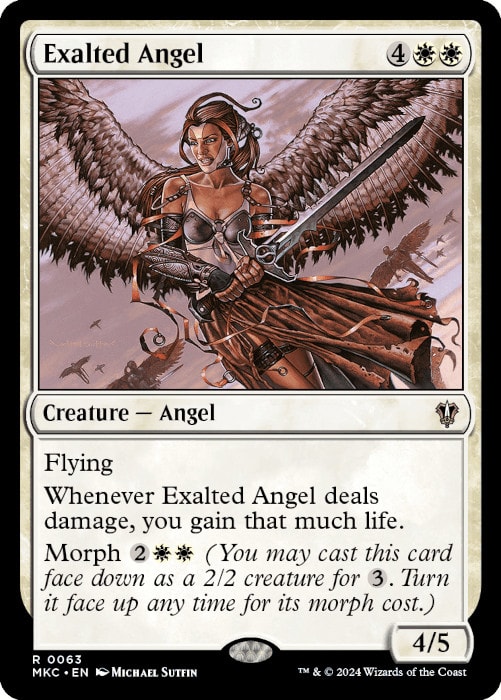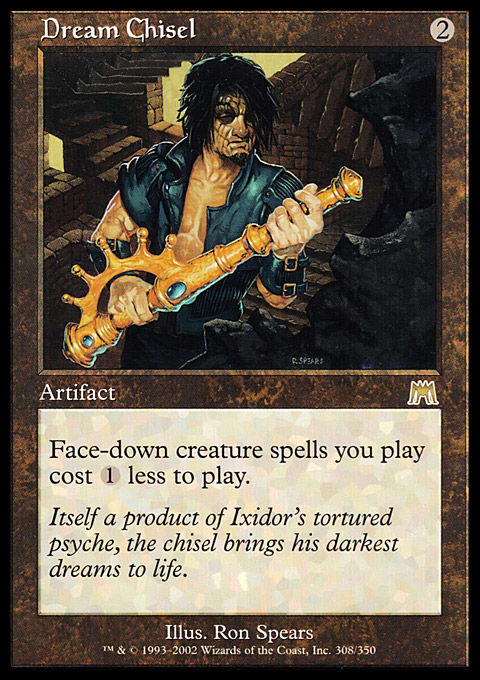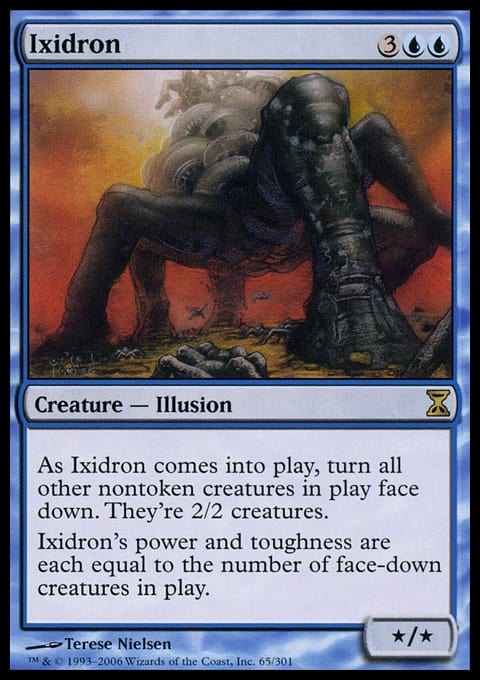Imagine a trip back in time, to 2002, at the release event for Onslaught. You walk up to a table where a Limited match is taking place. You examine the permanents on the battlefield, and much to your bewilderment you observe many face down cards in play.
A player unfamiliar with Magic may be confused by the flipped-over cards. A newer player may jump to the conclusion that these cards were put into play by either being Cloaked or Disguised (two mechanics my colleague, Brandon Ashcraft, discussed in a September 2024 article). While Cloaking and Disguising do something similar, they were both preceded by the original face-down mechanic, Morph!
The Morph Mechanic
What exactly is Morph, and how does it differ from Cloak or Disguise? When I hear the word "Morph," the first thing that comes to mind is the old Power Rangers television show. You know the one, where the characters turn into adept hand-to-hand combat warriors with the voicing of that catch phrase, "It's morphin' time!"

Unlike the television show, the Morph mechanic in Magic is a keyword ability that allows a player to pay three generic mana to cast a card with Morph face down as a 2/2 colorless, typeless creature. Don't be surprised if this sounds familiar--Disguise pretty much works in the same way, only disguised creatures get the added bonus of having Ward 2. Back in Onslaught times, you were less unhappy playing a generic 2/2 creature for three mana even without the ward ability.
Often times, a card with Morph have a triggered ability that's unlocked when the card is turned face-up. Let's take a look at an example: Echo Tracer, from Legions.
When this card is in your hand, you have two options to cast it. You can pay 2U to simply cast it as a 2/2 creature with no effects or you can play it face down as a 2/2 creature for 3. Then at a later time, at instant speed, you can pay to flip Echo Tracer up. When you do, you can return a creature to its owner's hand.
Here are a few notes regarding the basic rules surrounding Morph (which can be quite the complex mechanic):
- You can't normally cast a card face down. The morph ability allows you to do so.
- Any time you have priority, you may turn a face-down permanent you control with a morph ability face up. This is a special action that doesn't use the stack. (This means Voidmage Apprentice can be turned face up to counter a spell, even if that spell has Split Second).
- A manifested creature can be turned face up by paying its casting cost. A morphed creature can only be turned face up by paying its morph cost. If a creature without morph is turned face down, there's no cost to pay to turn it face up.
- If a face-down permanent leaves the battlefield, you must reveal it. You also must reveal it at the end of the game.
There are many other nuances and rules associated with Morph. Section 702.37 in the official rulebook dives into the rules associated with Morph, if you'd like to read further. Suffice to say, this is enough explanation to dive into some interesting examples.
Noteworthy Examples of Morph
When Morph first launched in Onslaught, it was an exciting and powerful mechanic that attracted much attention. Some of these cards have since fallen in popularity thanks to power creep, since a three mana 2/2 creature isn't worthy of its spot on the curve anymore. Still, there are at least a handful of noteworthy cards with Morph out of the 153 printed so far.
Let's start with possibly the most valuable card with Morph, Ebonblade Reaper.
The play pattern of this creature is pretty straightforward. You summon the Cleric as a face-down 2/2 creature. On a future turn, you attack with the creature, concealing what the card is until the very last moment. When your opponent decides not to block, you flip over Ebonblade Reaper and laugh maniacally when they lose half their life total, rounded up! You can only surprise them once, but it's an unsuspectingly powerful card worthy of inclusion in any deck that leverages face-down creatures.
Next on the list is my all-time favorite card with Morph, Exalted Angel.
This creature made huge waves during its time in Standard, as a turn four creature that can attack as a 4/5 flying lifelinker. Technically, Onslaught copies are much more valuable than Ebonblade Reaper, fetching over $20. Since Exalted Angel was reprinted in Murders at Karlov Manor Commander, you can find copies of the reprinted version for under a buck. Still, this card packs a hefty punch and swings above its weight when you consider how potent it can be when its flipped over on turn four. Exalted Angel is also one of my favorite angel illustrations; props to Michael Surfin for creating this beauty.
Creatures aren't the only card types to utilize the Morph mechanic. One of the more interesting Morph cards is Gift of Doom, a creature aura with Morph.
This card, printed in Commander 2019 (the last set to print new Morph cards), can be cast face down for three mana as a generic 2/2 creature. By sacrificing a creature, you can flip this card up and attach it to a creature at instant speed. It's a great way to surprise someone in combat out of nowhere, protecting your creature while simultaneously killing your opponent's.
Time Spiral block unsurprisingly introduced new cards with Morph (that block had like every ability ever printed). Then Wizards of the Coast got really creative by putting Morph on other non-creatures. For example, Lumithread Field is an Enchantment with a Morph cost.
Surprising your opponent by turning a creature face up and suddenly having an anthem effect seems really cool. It's a shame Lumithread Field only gave creatures +0/+1, making this card largely underwhelming and unplayable. Wizards also printed a land with Morph in Future Sight, called Zoetic Cavern. This land only taps for a colorless mana, so the card never did much.
Cards that Interact With Morph
A number of cards were also printed that interacted with the Morph mechanic, while not having Morph themselves. The classic example from Onslaught is Dream Chisel, which reduced the cost of all face-down creatures by one mana.
Funnily enough, Dream Chisel also reduces the cost of playing a Disguised creature face-down by one mana, providing a little bonus utility since its printing back in 2002. In Scourge, Wizards of the Coast created a card called Exiled Doomsayer, a 1/2 creature that increases all Morph costs by two generic mana. While a dagger in the heart of a Morph deck, this card has got to be one of the bulkiest rares of all time at this point.
Primal Whisperer doubles down on Morph by having a Morph ability itself and getting a +2/+2 bonus for each face-down card you have in play.
This makes the Elf Soldier a powerful inclusion in decks built around face-down mechanics such as Morph.
Backslide is an interesting instant from Onslaught, which turns a creature with Morph face down. It's a handy way of resetting one of your Morph creatures so you can flip it face up again to leverage its triggered ability a second time.
Last but not least, my favorite interaction with Morph: Time Spiral's Ixidron!
This creature is (in my opinion) an underutilized method for disrupting opponents' creature-based strategies. Black and White can cast cards like Damnation and Wrath of God, but Blue doesn't have many effective ways of sweeping the board of creature threats. Ixidron can take care of that for you, by turning all other creatures into innocuous 2/2 face-down creatures.
Often times my opponents will ask, "How do I turn the creatures face up again?" because they're unfamiliar with how Morph works. I simply instruct them to pay their creature's Morph costs, and then belt out an evil laugh when they understand the implication: they can't turn their creatures face up! They also can't place their commander back into the command zone because of Ixidron--their commander is stuck as a face-down 2/2 creature until they can somehow kill it.
Two Honorable Mentions
Before wrapping up, I want to acknowledge two important points related to Morph.
First, there was also a mechanic called Megamorph that was introduced in Dragons of Tarkir. The mechanic is basically Morph with one extra bonus. When you turn them face up and pay their megamorph cost, you put a +1/+1 counter on the creature. Incidentally, Wizards also crated a Myster Booster 2 card with Negamorph as a parody of Megamorph. Instead of receiving a +1/+1 counter, the creatures receives a -1/-1 counter when it's turned face up.
The second shout-out I want to mention is a pair of cards that date all the way back to Alpha, Magic's first set. It turns out Richard Garfield already had a vision for face-down cards in the game, evidenced by the printing of Illusionary Mask and Camouflage.
Both these cards were pioneers for leveraging face-down creatures in a game of Magic, simultaneously paving the way for hidden information on the battlefield via face-down creatures and giving judges massive headaches for the rules questions they incur. Camouflage has since been re-written to deliver upon the card's intent without turning creatures face-down, but it still remains a precursor to Morph, Cloak, and Disguise effects.
Wrapping It Up
Morph continues to be one of my all-time favorite mechanics in Magic. While the three mana cost for a generic 2/2 creature has become clunky and underpowered over the years, I love the idea of hidden information on the battlefield. The concept of hidden information, such as the cards in your opponent's hand, is one that makes Magic such a fun and skill-intensive game. Compounding this with face-down creatures provides even more opportunity to psych out an opponent during gameplay.
While we haven't seen new Morph cards since Commander 2019, Mark Rosewater has declared that the mechanic is a five on the Storm Scale, adding, "Odds are we'll see it again." Count me as one of the players excited to see this mechanic's return, even if it is somewhat outclassed by Disguise. There is a ton of design space with a mechanic like Morph--I look forward to see what the next iteration of the mechanic looks like!



































